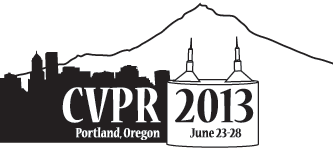-
Cumulative Attribute Space for Age and Crowd Density Estimation
AbstractA number of computer vision problems such as human age estimation, crowd density estimation and body/face pose (view angle) estimation can be formulated as a regression problem by learning a mapping function between a high dimensional vector-formed feature input and a scalarvalued output. Such a learning problem is made difficult due to sparse and imbalanced training data and large feature variations caused by both uncertain viewing conditions and intrinsic ambiguities between observable visual features and the scalar values to be estimated. Encouraged by the recent success in using attributes for solving classification problems with sparse training data, this paper introduces a novel cumulative attribute concept for learning a regression model when only sparse and imbalanced data are available. More precisely, low-level visual features extracted from sparse and imbalanced image samples are mapped onto a cumulative attribute space where each dimension has clearly defined semantic interpretation (a label) that captures how the scalar output value (e.g. age, people count) changes continuously and cumulatively. Extensive experiments show that our cumulative attribute framework gains notable advantage on accuracy for both age estimation and crowd counting when compared against conventional regression models, especially when the labelled training data is sparse with imbalanced sampling.
Related Material
[pdf][bibtex]@InProceedings{Chen_2013_CVPR,
author = {Chen, Ke and Gong, Shaogang and Xiang, Tao and Change Loy, Chen},
title = {Cumulative Attribute Space for Age and Crowd Density Estimation},
booktitle = {Proceedings of the IEEE Conference on Computer Vision and Pattern Recognition (CVPR)},
month = {June},
year = {2013}
}
These CVPR 2013 papers are the Open Access versions, provided by the Computer Vision Foundation.
Except for the watermark, they are identical to the accepted versions; the final published version of the proceedings is available on IEEE Xplore.
Except for the watermark, they are identical to the accepted versions; the final published version of the proceedings is available on IEEE Xplore.
This material is presented to ensure timely dissemination of scholarly and technical work.
Copyright and all rights therein are retained by authors or by other copyright holders.
All persons copying this information are expected to adhere to the terms and constraints invoked by each author's copyright.

